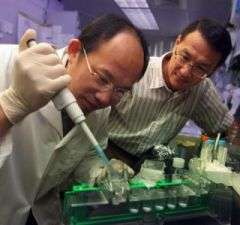Stabilizing Force for Good Communication Between Neurons and Muscle Cells Found

You can't raise a finger without your brain directing muscle cells, and scientists have figured out another reason that usually works so well.
A neuron sends a message, or neurotransmitter, to the muscle cell to tell it what to do. To get the message, the receiving cell must have a receptor. Oddly, the unstable protein rapsyn is responsible for anchoring the receptor so it's properly positioned to catch the message.
Medical College of Georgia scientists have found what keeps rapsyn in proper conformation.
It is a heat shock protein, one of a large family of molecular chaperones that make sure proteins get where they are needed and do what they should, says Dr. Lin Mei, chief of developmental neurobiology at MCG and Georgia Research Alliance Eminent Scholar in Neuroscience.
Hsp90β helps stabilize rapysn so receptors can get and stay where needed, according to research published in the Oct. 9 issue of Neuron. Dr. Mei suspects that other hsp siblings have a similar caretaker role in neuron-to-neuron communication in the brain.
Scientists knew rapsyn's role in getting neuromuscular receptors to aggregate and stay where needed, but they didn't know what stabilized it. "It makes you wonder how to control this naughty boy which is very important," says Dr. Mei, the study's corresponding author.
They found hsp90β wherever rapsyn clustered in muscle cells. When they disrupted its activity or expression, they realized hsp90β's stabilizing role in forming and maintaining receptor clusters, says Dr. Shiwen Luo, postdoctoral fellow in Dr. Mei's lab and the study's first author. Rapsyn and the receptor apparently interact, then hsp90β comes along to help stabilize the relationship.
Rapsyn mutations have been implicated in muscular dystrophies including congenital myasthenia gravis. MCG researchers are looking now to see if a mutated rapsyn still interacts with hsp90β.
They used a type of acetylcholine nicotinic receptor at the neuromuscular junction as a model for their studies of brain development and communication. The junction is 1,000 times larger than connections, or synapses, between two neurons but structurally similar. Fundamentals include presynaptic terminals that release neurotransmitters picked up by receptors on the postsynaptic side. Terminals and receptors must be lined up well, whether it's a muscle cell or neuron getting the message. "In central nervous system synapses and at the neuromuscular junction, receptors have to be concentrated at the right spot to receive the neurotransmitter released," says Dr. Mei. If receptors are in the wrong place, the message can be weak or even lost.
At the neuromuscular juncture, communication is usually straightforward, with primarily one neurotransmitter and one principal receptor. "Whenever you tell a muscle to move, it moves. If you want your muscles to think, you wouldn't be able to pick up a pin," says Dr. Mei. In the brain, where neurons have thousands of synapses, it's more of a negotiation. "Signals have to be integrated in the neuron for it to decide what to do."
Source: Medical College of Georgia





















